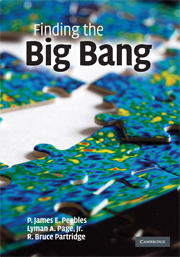Preface
Published online by Cambridge University Press: 05 July 2015
Summary
This is the story of a major advance in science, the discovery of fossil radiation left from the early stages of expansion of the universe – the big bang. Colleagues in informal conversations now only vaguely recalled led us to realize that this story is particularly worth examining because it happened in what was then a small line of research, and one that still is relatively simple compared to many other branches of physical science. That makes it well suited for an examination of how science actually is done, warts and all, in all the details – usually too numerous to mention – recalled by many of the people who did the work.
All the main steps in this story – the prediction, detection, identification, and exploration of the properties of the fossil radiation from the big bang – have been presented in histories of science. But these histories do not have the space (or the aim) to give an impression of what it was like to live through those times. We sense a similar feeling of incompleteness in many histories of science written by physicists, as well as by professional historians and sociologists. And there is a well-established remedy: assemble recollections from those who were involved in the work. An example in the broader field of cosmology – the study of the large-scale structure of the universe – is the collection of interviews in Origins: the Lives and Worlds of Modern Cosmologists (Lightman and Brawer 1990). We follow that path, but in more detail in a more limited line of research.
Early studies of the fossil radiation involved a relatively small number of people in what has proved to be a considerable advance in establishing the physical nature of the universe. This means we could aim for complete coverage of recollections from everyone involved in the early work who is still with us.
- Type
- Chapter
- Information
- Finding the Big Bang , pp. xi - xiiiPublisher: Cambridge University PressPrint publication year: 2009



